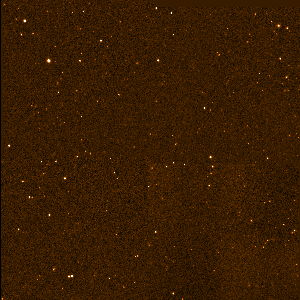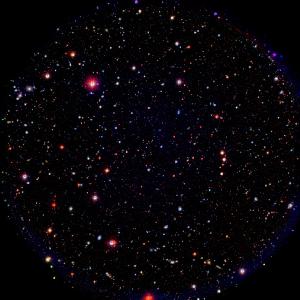Introduction:

Introduction: |

|
The Munich Near-IR Cluster Survey (MUNICS) is a wide-area, medium-deep, photometric survey selected in the K' band. It covers an area of roughly 1 square degree in the K' and J near-IR pass-bands with complementary optical photometry in the B, V, R, and I bands covering a subarea of 0.6 square degrees. The resulting object catalogues were strictly selected in K', having a limiting magnitude (50 per cent completeness) of K' approximately 19.5 mag and J approximately 21 mag, sufficiently deep to detect passively evolving systems up to a redshift of z <= 1.5 and luminosity of 0.5 L*. The optical data reach a depth of roughly R approximately 23.5 mag.
 |
 |
| 13x13 arcmin K-band image (472kB) |
15 arcmin VRI composite (111kB) (by Claus Gössl) |
The project's main scientific aims are the identification of
galaxy clusters at redshifts around unity and the selection of a
large sample of field early-type galaxies at 0 < z < 1.5 for
evolutionary studies. Further scientific goals are the examination
of the nature of extremely red objects (EROs)
and the QSO environments.
Directly observing the evolution of individual galaxies with time is,
unfortunately, not possible. Therefore we must rely on investigating
the statistical properties of the whole galaxy population as a
function of redshift, trying to draw conclusions from ensemble
properties on the evolution of typical members of these ensembles, and
thus facing difficulties, like, for example, discriminating between
luminosity evolution and number density evolution.
Selection in a single pass-band introduces different selection
effects. These selection effects can be used deliberately for
probing different galaxy populations and different aspects of their
evolution. While selection in blue pass-bands is used to study star
forming sources, selection in the near-IR is predominantly sensitive
to the light of old stellar populations. Near-IR k-corrections are
small even at redshifts above unity and insensitive to the spectral
type of the observed objects
(Cowie et al. 1994)
and to short-lived bursts of star formation, as has been pointed out
by Kauffmann & Charlot (1998)
Thus near-IR selected surveys are thought to be much less biased with
respect to the mix of spectral types compared to optically selected
surveys. Furthermore, the uncertainties resulting from inhomogeneous
dust absorption are minimal in the near-IR. It has therefore been
concluded that near-IR selection is a feasible attempt at a selection
in stellar mass
(Rix & Rieke 1993;
Brinchmann & Ellis 2000).
The Munich Near-Infrared Cluster Survey (MUNICS) is an attempt at
closing the gap between previously undertaken infrared-selected deep
pencil-beam surveys
(Gardner, Cowie, & Wainscoat 1993;
Mc Leod et al. 1995;
Cowie et al. 1994;
Djorgovski et al. 1995;
Williams et al. 1996;
Saracco et al. 1997)
and relatively shallow wide-area surveys
(Mobasher, Sharples, & Ellis 1993;
Glazebrook et al. 1994;
Gardner et al. 1997).